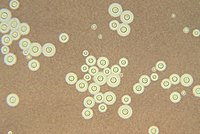
Photo from wikipedia
Cryptococcus neoformans and Cryptococcus gattii can cause cryptococcosis, which has a high mortality rate. To treat the disease, amphotericin B and fluconazole are often used in clinic. ABSTRACT Infection of… Click to show full abstract
Cryptococcus neoformans and Cryptococcus gattii can cause cryptococcosis, which has a high mortality rate. To treat the disease, amphotericin B and fluconazole are often used in clinic. ABSTRACT Infection of Cryptococcus neoformans is one of the leading causes of morbidity and mortality, particularly among immunocompromised patients. However, currently available drugs for the treatment of C. neoformans infection are minimal. Here, we report SP1, a peptide derived from glyceraldehyde-3-phosphate dehydrogenase (GAPDH) of Saccharomyces cerevisiae, efficiently kills C. neoformans and Cryptococcus gattii. SP1 causes damages to the capsule. Unlike many antimicrobial peptides, SP1 does not form pores on the cell membrane of C. neoformans. It interacts with membrane ergosterol and enters vacuole possibly through membrane trafficking. C. neoformans treated with SP1 show the apoptotic phenotypes such as imbalance of calcium ion homeostasis, reactive oxygen increment, phosphatidylserine exposure, and nuclear fragmentation. Our data imply that SP1 has the potential to be developed into a treatment option for cryptococcosis. IMPORTANCE Cryptococcus neoformans and Cryptococcus gattii can cause cryptococcosis, which has a high mortality rate. To treat the disease, amphotericin B and fluconazole are often used in clinic. However, amphotericin B has rather high renal toxicity, and tolerance to these drugs are quicky developed. The peptide SP1 derived from baker’s yeast GAPDH shows antifungal function to kill Cryptococcus neoformans and Cryptococcus gattii efficiently with a high specificity, even for the drug-resistant strains. Our data demonstrate that SP1 induces the apoptosis-like death of Cryptococcus neoformans at low concentrations. The finding of this peptide may shed light on a new direction to treat cryptococcosis.
Journal Title: Microbiology Spectrum
Year Published: 2022
Link to full text (if available)
Share on Social Media: Sign Up to like & get
recommendations!